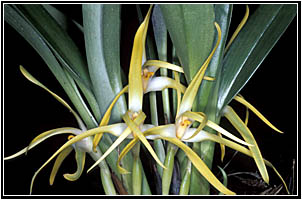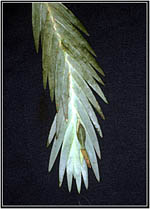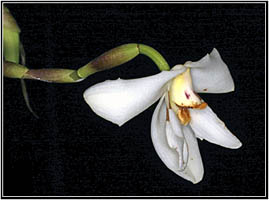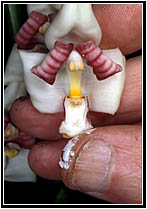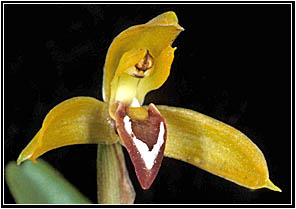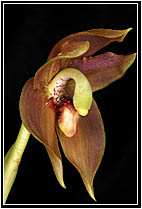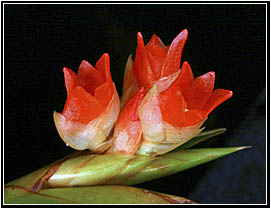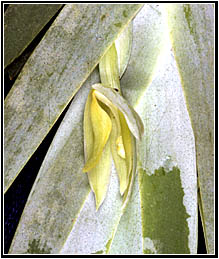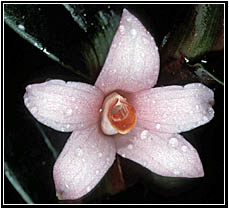|
Evolutionary
Relationships within Tribe Maxillarieae
|
Mark Whitten is a botanist at the Florida Museum of Natural
History in Gainesville Florida.
His research interests include molecular systematics of orchids
and chemical ecology of orchids Euglossine bees.
He is presently working on the molecular systematics of Maxillaria
in collaboration with colleagues in Mexico, Costa Rica, Ecuador
and Brazil.
|
|
|
ON:
Your lecture concerns Evolutionary Relationships within Tribe Maxillarieae:
Lessons from Molecules, Morphology, and Pollination Biology. How long
have you been studying the tribe to get those results?
|
MW:
In fact, I developed this work with Norris H. Williams.
Our research was originally focused on studying floral fragrances
of orchids pollinated by male euglossine bees, such as
Gongora and Stanhopea, using gas chromatography/mass
spectrometry. This work built upon the pioneering work of Dodson,
Dressler, Norris Williams, and others. Species in the Stanhopeinae
usually have species-specific floral fragrances, and the pollinating
bees seemed to be better orchid taxonomists than the botanists.
Analyzing the floral fragrances helped to define species, but
it was not very useful for determining how orchid species and
genera were related. When DNA sequencing became a taxonomic tool
in the mid 1990s, Mark Chase invited me to visit his lab to learn
|

Sievekingia butcheri |
|
the techniques and we began a molecular phylogenetic study ofStanhopeinae.
We have gradually expanded our studies to other subtribes, including
Oncidiinae (with Norris Williams), Bifrenariinae
(with Samantha Koehler), Zygopetalinae (with Robert Dressler
and Guenter Gerlach)and now Maxillariinae (with German
Carnevali, Samantha Koehler, and Rodrigo Singer).
In the most recent orchid classification proposed by Chase et
al. (2003), these subtribes are now included in a broader tribe
Cymbidieae, instead of Maxillarieae.Chase, M.W.,
K.M. Cameron, R.L. Barrett, and J.V. Freudenstein. 2003. DNA data
and Orchidaceae systematics: A new phylogenetic classification.
Pp. 69-89 in K.W. Dixon, S.P. Kell, Rl. Barrett and P.J. Cribb
(eds.) Orchid Conservation. Natural History Publications (Borneo),
Kota Kinabalu, Sabah.
|
 Tolumnia
urophylla / Onc ampliatum
Tolumnia
urophylla / Onc ampliatum |
|
|
|
|
|
Max.
gentryi
|
Max.
witsenioides
|
Max.
platypetala
|
|
|
|
|
|
Max.
hillsii
|
Max.
notylioglossa
|
Chrysocycnis
schlimii.
|
ON: What can you tell us about the modifications inside this tribe due
to the DNA sequence data?
MW: At the subtribal level, the DNA data revealed
a few surprises. For example, Cryptarrhena (an odd Central American
genus of about 2 species) traditionally has been placed in its own subtribe,
but DNA data show it is firmly embedded within the Zygopetalinae.
Its vegetative habit and many-flowered inflorescence are aberrant within
Zygopetalinae, but if one looks at the flowers, they have an
anchor-shaped lip, similar to Dichaea, and a hooded column (clinandrium)
similar to Huntleya. So, we no longer recognize subtribe Cryptarrheninae.
Similarly, the subtribes Pachyphylliinae, Telipogoninae
(Andean groups) and Ornithocephalinae (Ornithocephalus,
Sphryrastylis) traditionally have been separated from Oncidiinae
on the basis of pollinium number (four vs. two). The DNA data clearly
show that these clades are embedded within the Oncidiinae, indicating
that there has been an evolutionary increase in pollinium number within
Oncidiinae from two to four. This provides an important lesson
to not rely on a few key morphological characters a priori to construct
a classification.
ON: As you said many spectacular and horticulturally important genera
such as Oncidium, Odontoglossum, Stanhopea, Zygopetalum,
Maxillaria are found in this tribe, which are the others?
MW: Well, if those are not enough, you can include
genera such as Lycaste, Ida, Anguloa (Lycastinae) and
Bifrenaria (Bifrenariinae). The genus Xylobium
seems to be distinct and not clearly sister to any other subtribe, and
should probably best be treated as a separate subtribe. Xyobium
is not very showy, but is a moderately large and interesting genus that
would make a nice thesis topic for a student.
|
|
|
|
|
Max.
horichii
|
Max.
witsenioides
|
Max
scalariformis
|
ON: Do you
think there will be many changes inside the genus Oncidium?
Do you have any idea of how many others genera should be created?
MW:Oh, yes! The Oncidiinae is the subtribe
that is suffering the most taxonomic changes. There are clear biological
reasons for this (see next question), but the changes are especially
contentious because the Oncidiinae (like the Laeliinae)
contains so many horticulturally important species. Orchid growers
and hybridizers dont like to have to learn new names for their familiar
plants, so it is important that:
1) any nomenclatural changes are based upon solid phylogenetic evidence
and
2) generic changes are made with an emphasis to minimize nomenclatural
transfers (name changes).
Norris Williams, Mark Chase, and Cida Farina are the primary researchers
on Oncidiinae phylogenetics, and have sampled over 500 species
for three DNA regions. Combined with careful morphological analyses,
we believe this will ultimately lead to a more stable and predictive
classification, instead of one based largely on taxonomic authority
and opinion.
Taxonomists have all agreed for years that many generic distinctions
were artificial, such as Oncidium vs. Odontoglossum
(based on the angle of the lip and column).
Now, we must collaboratively gather enough data that can be analyzed
objectively to delimit evolutionary groups (monophyletic clades),
and then we must decide how to name these clades to minimize nomenclatural
changes.
|
ON:
You said that the DNA data support
traditional classifications within subtribes
that produce legitimate floral rewards
(e.g., Stanhopeinae); on the other hand,
subtribes that contain many species
with deceit-based pollination systems
(e.g. ), the DNA-based trees
conflict strongly with traditional classifications.
Could you tell us a little more about this?
|
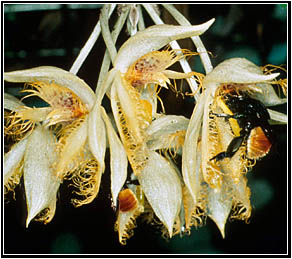 Sievekingia
reichenbachiana
Sievekingia
reichenbachiana |
MW: Yes, Stanhopeinae are taxonomically well-behaved; for the
most part, the genera are easy to recognize (e.g., Gongora vs.
Stanhopea vs. Coryanthes). As far as we know, all Stanhopeinae
are pollinated by fragrance-collecting male euglossine bees that
collect perfumes from the flowers.
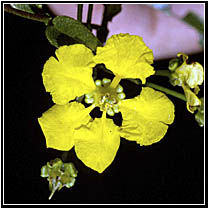 Malphighia
sp
Malphighia
sp
|
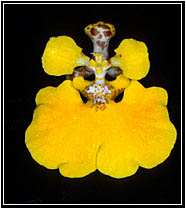 Oncidium
ampliatum
Oncidium
ampliatum |
The different genera represent different pollination mechanisms that
have evolved to attach the pollinaria to different sites on the bees
body (head or thorax or leg). The DNA-based trees agree very well with
the traditional generic classification based on floral morphology.In
contrast, Oncidiinae contain many species that do not produce
a legitimate floral reward to the pollinators; they deceive the insects
by mimicking the appearance of other species that produce a floral reward
such as nectar or oil. The clearest example is provided by the stereotypical
yellow Oncidium flower. These are probably mimics of yellow flowers
of Malpighia, which produce an oil reward. This oil is collected
by female anthophorid bees and used to feed their larvae. Many
different species within Oncidium have evolved a yellow flower
with clawed sepals and petals that superficially resembles a yellow
Malpighia; these orchid flowers produce no legitimate reward,
but deceive the bees into an occasional visit that results in pollination.
|
To
make matters more confusing, some Oncidiinae (e.g., Cyrtochilum
and Sigmatostalix) have oil glands that provide a legitimate
reward for the oil collecting bees. In the Andes of Ecuador, yellow
flowered Calceolaria are common along roadsides and are
pollinated by bees collecting oil secreted by trichomes inside
the lip. We suspect that at least some Oncidiums [e.g., Oncidium
harlingii (now Otoglossum)] are mimics of Calceolaria.
Other
Oncidiinae have evolved long spurs that produce nectar
to attract butterflies or hummingbirds (Comparettia), and
others have long spurs but do not produce any nectar (Trichocentrum
s.s.). So, it seems that most of our taxonomic confusion is caused
by our heavy focus on floral colors and shapes, and by not recognizing
that these floral syndromes may have evolved several times within
a lineage of orchids.
Another good example is the genus Cryptocentrum, whose
flowers are green, fragrant at night, and have a long nectariferous
spur. The DNA data show that Cryptocentrum is embedded
within Maxillaria (as currently defined).
Cryptocentrum is simply an odd Maxillaria that has
evolved moth pollinated flowers, the only group with this pollination
syndrome within Maxillariinae.
Similarly, Trigonidium, Chrysocycnis, and Mormolyca
represent independent evolutionary adaptations to pseudocopulation
from within a polyphyletic Maxillaria.
|
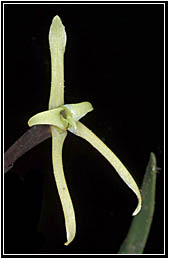 Cryptocentrum
latifolium
Cryptocentrum
latifolium |
ON: You also affirm that convergent evolution may produce very similar
floral morphologies in unrelated orchids; classifications based primarily
upon gross floral characters may be misleading. Which are the consequences
for modern classification of orchids?
MW: I think everyone would agree that classifying
orchids based solely upon flower color is simplistic and unnatural;
for example, we all agree that an orange Epidendrum is not closely
related to an orange Sophronitis.
I think that the evidence from DNA-based trees is teaching us that floral
morphology in orchids is very evolutionarily plastic and labile, and
that we have relied too much on simplistic floral traits in constructing
our previous classifications. Interestingly, in the Oncidiinae,
we are discovering that vegetative features often provide better taxonomic
characters at the generic level than do floral features.
ON: We know that you have an important project that will really change
the classification of Orchidaceae. What could you tell us about it?
MW: Well, right now its just a proposal for a
research project. The US National Science Foundation has a special grant
program called Assembling the Tree of Life. Its aim is to provide funds
for phylogenetic studies for major branches of the tree of life, such
as the orchid family. This year, we submitted a proposal to construct
a generic level phylogeny of the entire orchid family, based on a sampling
of about 1500 carefully chosen species sequenced for six DNA regions.
This would be a large collaborative project over five years with participants
from all over the world, including Cassio van den Berg, Samantha Koehler,
Rodrigo Singer, and many others. Even if this project is funded (the
awards will be announced this August), it will not provide a final,
definitive classification. Hopefully, it would provide a solid framework
that would help guide more focused, intensive studies of orchid genera
or subtribes.
With 25,000 species of orchids, there will be plenty of work for future
students.
ON: Thank you, Mark Whitten
Photos by Mark Whitten
|
Any
kind of reproduction (print, digital or anyone other) of any
type of material of this site - texts,
layout, photos, images and others - is strictly forbidden without
previous written permission by the authors.
|

|


